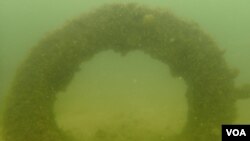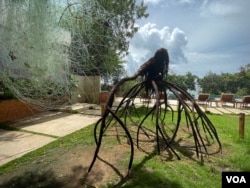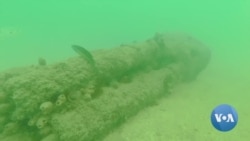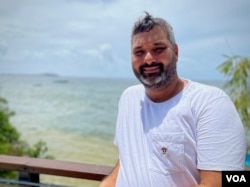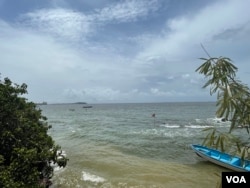Waves lap up against the beach outside Oceanium, a scuba diving center and environmental organization in Dakar’s southern Plateau neighborhood. About 100 meters offshore and 5 meters below, eight sculptures rise from the ocean floor.
Dutch and Italian artists Mischa Sanders and Philipp Putzer created the sculptures during an art residency in Dakar.
VOA and other media were not able to visit the sculptures during a planned visit Monday due to poor visibility and rough seas.
The works debuted at Dakar’s art biennale, which continues through Tuesday. The goal is to bring more awareness to the pollution that surrounds the sculptures, and thereby encourage a conversation about the environment.
Charlotte Thomas is Oceanium’s head of communications.
"You see, here in Senegal, the pollution is everywhere," Thomas said. "You go into Dakar and you see waste all around you. And with the rainy season coming, it’s going to go into the sea. So, if we are not protecting our land, we cannot protect our sea."
Watch related video by Allison Fernandes:
Besides Senegal’s rampant plastic pollution, a surge of development projects over the last decade has transformed the coastline and eroded fragile ecosystems. Fish stocks have plummeted as commercial and artisanal fishing boats continue to use unsustainable fishing practices.
In 2015, the government passed a law banning single-use plastics, but it was never enforced. Since then, versions of the law have passed, including in 2020 when legislation specifically targeted plastic cups, straws, plates, bags and bottles, but those never went into effect either.
Senegal-born Rodwan El Ali is the diving director of Oceanium and for the underwater exhibit. He has spent much of his life diving in Dakar.
El Ali said in French, “I live underwater, and I can see that the areas that were so beautiful when I was young, today not only are there no fish left, but they’ve been replaced by plastic bottles, cans and all sorts of things. It’s painful for me.”
El Ali said he used to see plenty of dolphins, whales and sharks, and catch fish that were his size. Now, he said, there’s barely anything left.
“We’re in a country where the environment is not a priority,” he said. “Maybe [politicians] mention it in speeches, but in reality they do nothing. No one is monitoring, no one is doing anything. You could go out to sea and do whatever you want and no one will stop you.”
Since the sculptures were placed underwater in December, they have given rise to their own ecosystem. The clay structures are covered in barnacles, shellfish and urchins. Fish visit frequently to find refuge and feed on algae.
Oumy Diaw is a specialist of contemporary art. What she finds most interesting about the installation, she said, is that the statues look like coral – a unique sight in Dakar’s barren waters.
“The bay is just full of sand, there’s absolutely no corals," Diaw said. "So, it’s interesting to see how contemporary art is trying to mimic what nature can bring by exploring natural ingredients that can cohabitate with the environment.”
That Dakar is the contemporary art capital of the continent gives the work a particularly large platform, she said.
Organizers say they plan to commission local artists to create new sculptures that will be added to the exhibit over time.




